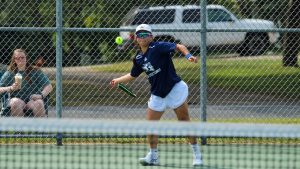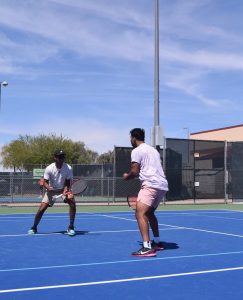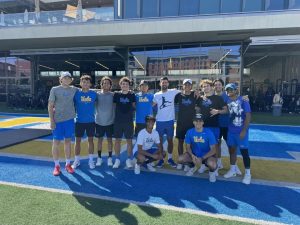The Role of Tennis in the University Life
The Benefit of Tennis through Three Perspectives
EDUC 200 Student, Joy Lu, Scarlett Jiang, Emma Chang
In today’s fast-paced academic environment, university students face a myriad of challenges that extend beyond the classroom. The collegiate ideal experience aims to provide a holistic education that nurtures not only the intellectual but also the physical, emotional, and social aspects of students’ lives. Central to this philosophy is the concept of thick institutions, which emphasize the importance of routine, community, and a sense of belonging. These institutions create strong, supportive environments where students can form meaningful relationships and thrive. As we explore the theme “Does Tennis Benefit University Students’ Mental Health?” it becomes clear that tennis offers numerous mental health benefits, such as reducing stress and improving mood, aligning seamlessly with the principles of thick institutions. By integrating tennis into the college experience, universities can promote a more balanced and fulfilling life for their students.
The social benefits of tennis: In terms of the mental health benefits of tennis, a large part of the sport is social interaction within the sport. According to an article from USTA discussing the social benefits of tennis, they state, “Whether you are playing doubles or singles, you are constantly communicating and interacting with your partner or opponent.” Furthermore, when I interviewed a friend of mine who is quite active within the UW tennis community, she talked about how she has been able to foster closer relationships with people she may not initially have. They play routinely at the outdoor courts, which is one of the traits of a thick institution, building a warm community and place that they all are able to come back to. This is quite important, as it emphasizes the positive social interaction that occurs on the court, creating a wonderful environment to foster one’s mental health.
How tennis is a break from academic pressures: The concept of a “thick institution” encompasses organizations or communities that provide substantial support and enrichment to their members, enhancing their overall well-being and personal development. In the context of tennis, this idea is reflected in how the sport serves as a break from academic pressures. As illustrated by a friend’s experience, “Playing tennis can help me temporarily forget about the pressure from school because it gives me happiness from playing sports, especially playing tennis with my friends. Sometimes, sports can stimulate dopamine in your body to give me happiness and relief from academic pressures.” This example demonstrates how tennis, as part of a thick institution, offers not only physical exercise but also social interaction and mental relief. By creating a supportive environment where students can enjoy sports, build friendships, and experience the physiological benefits of dopamine release, tennis exemplifies the multifaceted support that thick institutions provide to help individuals manage stress and thrive both academically and personally.
The correlation of physical health with mental health through tennis: At the University of Washington, tennis has proven to be a significant contributor to both the physical and mental well-being of students. According to an interview conducted with members of our community, “Everyone engaged with tennis, whether playing or spectating, reports high levels of happiness and satisfaction in college’s tennis club,” underscoring the sport’s positive impact. Notably, our tennis program is not just a team but a cornerstone of campus life, fostering a vibrant, supportive community. This observation aligns with cases from other thick institutions, such as UCLA, where tennis star Novak Djokovic participated in sessions with college students, highlighting the sport’s appeal and its role in promoting a healthy, active lifestyle. The robust engagement with tennis at the University of Washington exemplifies how integrating sports into university life can lead to a thriving, health-conscious student body. It also creates a community where students can engage in collage activity.
Tennis offers many mental health benefits, such as reducing stress and improving mood, and aligns with the principles of thick institutions that emphasize routine and a sense of belonging. These institutions help foster strong relationships and supportive environments, contributing to overall well-being. The holistic approach to education emphasizes the development of the whole person, integrating physical activities like tennis to promote mental, emotional, and social growth. By combining all of these elements, we can see the benefits of tennis, as it nurtures all aspects of university students’ lives, leading to a more fulfilling and balanced life.



Citation(s): Wanninger, L. (2023, May 2). Tennis is Good for Your Mental Health. USTA Southern California.
Our group used Chat GPT as a resource to help us revise grammar.
Media Attributions
- A girl playing tennis © Reese Kupsky is licensed under a CC BY-NC-SA (Attribution NonCommercial ShareAlike) license
- Two players celebrating their win © Husky Tennis Club Instagram is licensed under a CC0 (Creative Commons Zero) license
- Novak Djokovic trains with UCLA students ahead of Indian Wells © Novak Djokovic is licensed under a CC BY-NC-SA (Attribution NonCommercial ShareAlike) license

